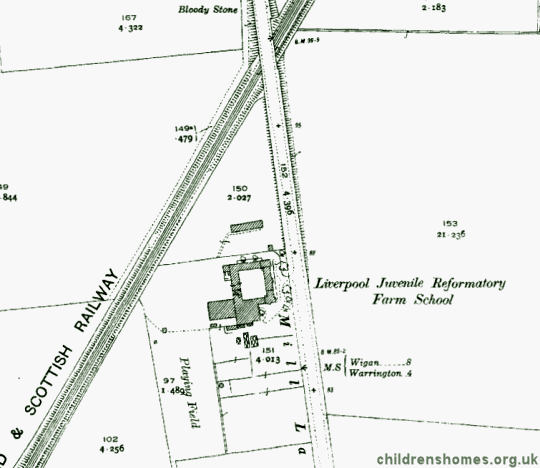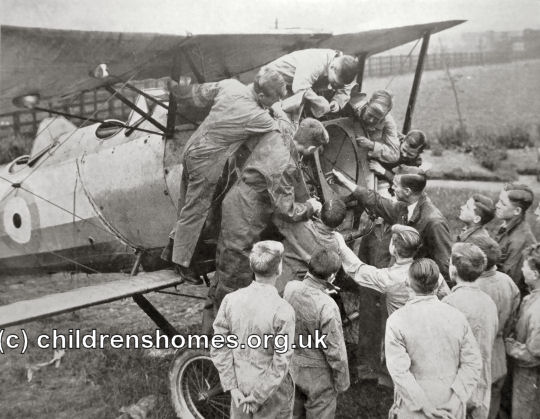Liverpool Reformatory Farm School for Boys, Newton-le-Willows, Lancashire
In 1858, the Liverpool Juvenile Reformatory Association (LJRA) who operated the Training Ship Akbar and the girls' reformatory at Edge Hill, began to look for a site on which to open a reformatory for boys. Mr Richard Hughes Atty was commissioned by the LJRA Committee to gather information from other reformatories in operation and to formulate a plan for the scheme. Atty's proposals impressed the Committee. Not only was he given the task of finding a suitable site, at an affordable price, but he was also made Superintendent of the establishment, a post he was to hold until his death in 1888.
The reformatory was original located in a property known as Bridge Park on Mill Lane (now Winwick Road), Newton-le-Willows, which had been leased for ten years. It was officially certified for operation on April 6th, 1859. Towards the end of the lease period, another site was purchased nearby and in 1867 a new building was erected as the institution's permanent home. It could accommodate 140 boys up to 14 years in age.
The location of the School is shown on the 1928 map below.

Liverpool Reformatory Farm School for Boys site, Newton-le-Willows, c.1928.
Official inspections of the school generally found discipline and education to be satisfactory. As might be expected, agricultural work formed the basis of much of the industrial training provided at the School which had 32 acres of farmland and a well cultivated garden. The boys also performed work for neighbouring farmers. Other occupations engaged in by the inmates included tailoring, shoemaking, and carpentry and joinery. The School generated an income from the manufacture of wooden boxes, and chopping wood. A flour mill was worked by the boys under supervision, while paper mills in the neighbourhood regularly employed around 24 of their number.
The School's dietary table from 1907 is shown in the table below.
| DAY | BREAKFAST | DINNER | SUPPER |
|---|---|---|---|
| SUNDAY | 1 pint of Coffee, with Milk and Sugar, 8 or 12 oz. of Bread | 6 oz. Meat, Roasted, 8 oz. Potatoes. 4 oz. Bread. |
8 oz. of Bread, with Butter, 1 pint Tea, with Milk and Sugar. |
| MONDAY | 8 or 12 oz. of Bread, 1 pint of Coffee of Cocoa. | 1 pint of Soup, containing— 6 oz. of Meat, 2 oz. of Peas, Rice and Vegetables, 8 oz. of Bread. |
8 oz. of Bread, with Butter, 1 pint Tea, etc. |
| TUESDAY | 6 oz. Bread, Porridge with Milk and Sugar, (3 oz. Oatmeal) | 1 lb. Suet Pudding, Treacle or Stewed Rhubarb, or Fish, with 3 oz. Rice, 8 oz. Potatoes. | 8 oz. of Bread, with Butter, 1 pint Tea, etc. |
| WEDNESDAY | 8 or 12 oz. of Bread, 1 pint of Coffee of Cocoa. | Stew containing— 6 oz. Meat, 12 oz. Potatoes, Pot Herbs, etc. 4 oz. Bread. |
8 oz. of Bread, with Butter, 1 pint Tea, etc. |
| THURSDAY | 6 oz. Bread, Porridge with Milk and Sugar, (3 oz. Oatmeal) | 6 oz. Meat, Roasted, 8 oz. Potatoes. 4 oz. Bread. |
8 oz. of Bread, with Butter, 1 pint Tea, etc. |
| FRIDAY | 8 or 12 oz. of Bread, 1 pint of Coffee of Cocoa. | Soup, 1 pint 3 Bullocks Heads and Vegetables, 8 oz. Bread. |
8 oz. of Bread, with Butter, 1 pint Tea, etc. |
| SATURDAY | 6 oz. Bread, Porridge with Milk and Sugar, (3 oz. Oatmeal) | 12 oz. of Bread, 2 oz. of Cheese, or Dripping, or Butter. 1 pint of Cocoa. |
8 oz. of Bread, with Butter, 1 pint Tea, etc. |
| In Season—Lettuce, Onions, Radishes, and Rhubarb are given with the evening meal. Jam is supplied occasionally on Sundays and Holidays. |
|||
In around 1933, the reformatory was redesignated as an Approved School for Intermediate Boys, one of the new establishments introduced by the Children and Young Persons Act of 1932. It then housed up to 115 boys aged from 13 to 15. The institution was renamed Red Bank School in 1950.

Metalworkers in training at Liverpool Farm School, c.1937. © Peter Higginbotham
In 1948, part of the site was assigned for use as a Classifying School, performing assessment of boys entering the Approved School system before they were distributed to other establishments. The main part of the school then became known as the Training School. In around 1970, the two sections were renamed as the Assessment Unit and the Training Unit respectively. A third section, the Special Unit, was created in 1966 to provide secure accommodation for a small number of boys.
In 1973, the school became Community Home with Education (CHE) under the control of Lancashire County Council, later passing to St Helens Metropolitan Borough in 1992.
The buildings no longer survive and the site is now covered by modern housing.
Records
Note: many repositories impose a closure period of up to 100 years for records identifying individuals. Before travelling a long distance, always check that the records you want to consult will be available.
- Lancashire Record Office, Bow Lane, Preston, Lancashire, PR1 2RE. Holdings include LFS Admission Register (1911-62; 1973-4); Boys' Report Files (1953-64); LFS Dental Register (1932-39). (Records subject to 75 year closure.)
Census
Bibliography
- Rimmer, Joan Yesterday's Naughty Children (1986, Neil Richardson)
- Carpenter, Mary Reformatory Schools, for the Children of the Perishing and Dangerous Classes, and for Juvenile Offenders (1851, General Books; various reprints available)
- Carlebach, Julius Caring for Children in Trouble (1970, Routledge & Kegan Paul)
- Higginbotham, Peter Children's Homes: A History of Institutional Care for Britain's Young (2017, Pen & Sword)
- Abel Smith, Doroth Crouchfield: A History of the Herts Training School 1857-1982 (2008, Able Publishing)
- Garnett, Emmeline Juvenile offenders in Victorian Lancashire: W J Garnnett and the Bleasdale Reformatory (2008, Regional Heritage Centre, Lancaster University)
- Hicks, J.D. The Yorkshire Catholic Reformatory, Market Weighton (1996, East Yorkshire Local History Society)
- Slocombe, Ivor Wiltshire Reformatory for Boys, Warminster, 1856-1924 (2005, Hobnob Press)
- Duckworth, J.S. The Hardwicke Reformatory School, Gloucestershire (in Transactions of the Bristol and Gloucestershire Archaeological Society, 1995, Vol. 113, 151-165)
Links
- Red Lodge Museum, Bristol — a former girls' reformatory.
Except where indicated, this page () © Peter Higginbotham. Contents may not be reproduced without permission.


